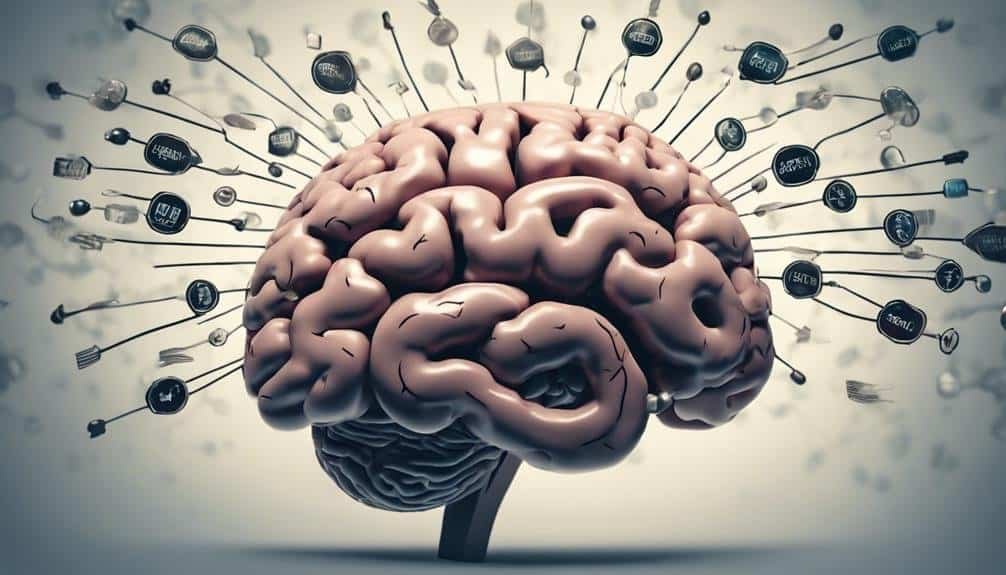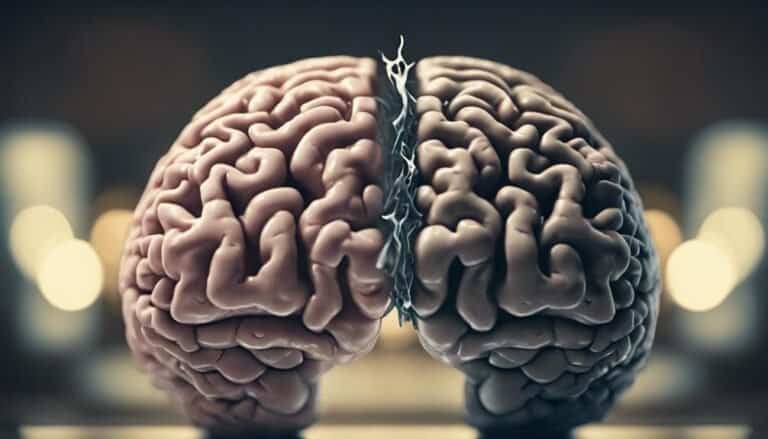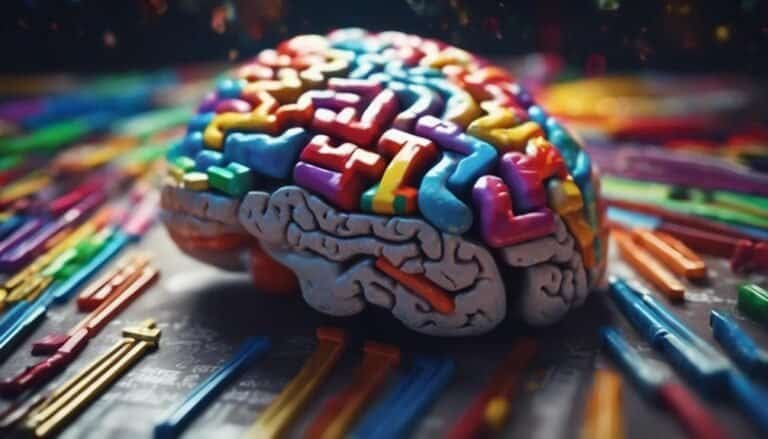Brain's Influence on Self-Esteem
When you receive a compliment from a friend, you might feel a surge of happiness and confidence. But have you ever considered how your brain is intricately linked to your self-esteem?
The way your brain processes information, regulates emotions, and forms perceptions about yourself plays a significant role in shaping your self-worth. Understanding these neural mechanisms can provide valuable insights into why some individuals struggle with confidence while others exude self-assurance effortlessly.
Key Takeaways
- Neural connections shape self-esteem and self-image.
- Dopamine boosts confidence levels and motivation.
- Prefrontal Cortex guides decision-making and risk assessment.
- Stress impacts self-perception through cortisol levels.
Neurobiology of Self-Esteem
The brain's neurobiology plays a crucial role in shaping an individual's self-esteem, influencing perceptions of self-worth and confidence. Neural connections within the brain form the basis of how we perceive ourselves, impacting our self-image perceptions. These connections are constantly being shaped by our thoughts, experiences, and interactions with the world around us.
When neural pathways associated with positive self-esteem are reinforced, individuals tend to have a healthier self-image and higher levels of confidence. On the other hand, negative neural connections can lead to self-doubt and low self-esteem. It's essential to understand that these neural pathways aren't fixed; they can be altered through conscious effort and therapeutic interventions.
Role of Amygdala in Emotions
Indefinite pronoun 'One' could be used to improve readability.
Understanding the amygdala's role in emotions is crucial for grasping the intricate workings of the human brain. The amygdala, a small almond-shaped structure in the brain, plays a significant role in emotional regulation and fear response. Here's how it influences your emotions:
- Emotional Regulation: The amygdala is involved in processing emotions, especially fear and pleasure. It helps in identifying potential threats in the environment and triggers appropriate responses to ensure survival.
- Fear Response: When faced with a perceived danger, the amygdala signals the body to enter a state of heightened alertness, known as the fight-or-flight response. This physiological reaction prepares you to either confront the threat or flee from it.
- Memory Formation: The amygdala also plays a crucial role in associating emotions with memories. This connection between emotions and memories can significantly impact how you perceive and respond to different situations.
Understanding how the amygdala functions can provide valuable insights into how emotions are processed and regulated in the brain.
Prefrontal Cortex and Decision-Making
When faced with decisions, your prefrontal cortex plays a crucial role in evaluating choices and exercising cognitive control. This part of your brain helps you navigate complex scenarios and make informed judgments based on various factors.
Understanding how neural pathways function in decision-making can shed light on how your brain processes information to guide your choices.
Neural Pathways in Decisions
Within your brain, the prefrontal cortex plays a crucial role in decision-making processes. The neural pathways in decisions are intricate, involving various regions working in harmony to guide your choices.
Here's a closer look at how these pathways influence your decision-making:
- Prefrontal Cortex Activation: This region is responsible for assessing risks, rewards, and consequences, helping you make informed decisions.
- Emotional Regulation: Neural pathways connecting the prefrontal cortex with emotional centers like the amygdala impact how emotions influence your choices.
- Cognitive Flexibility: The ability of these pathways to adapt and change, known as brain plasticity, allows you to learn from past decisions and adjust your future choices.
Understanding these neural pathways can empower you to enhance your decision-making skills and navigate life's complexities more effectively.
Cognitive Control and Choices
To enhance your decision-making abilities, understanding the role of the prefrontal cortex in cognitive control and choices is essential. The prefrontal cortex plays a crucial part in cognitive flexibility, allowing you to adapt your mindset and approach to different situations.
By nurturing cognitive flexibility, you empower yourself to make informed decisions that align with your goals and values. This brain region is instrumental in weighing options, predicting outcomes, and regulating emotions to guide your choices effectively.
Strengthening the connections within the prefrontal cortex through practice and reflection can enhance your overall decision-making skills. Embracing this understanding of the prefrontal cortex's role in decision making can lead to a greater sense of empowerment and confidence in your choices.
Impact of Dopamine on Confidence
When dopamine levels are optimal, they play a crucial role in boosting your confidence levels.
This neurotransmitter has a direct link to how self-assured you feel in various situations.
Understanding the impact of dopamine on confidence is key to comprehending its role in shaping your self-esteem.
Dopamine and Confidence Link
Dopamine plays a crucial role in linking confidence with brain function. When dopamine levels are balanced, your confidence tends to be stable and strong. Here's how dopamine influences your confidence levels:
- Motivation: Dopamine helps drive you towards your goals, boosting your self-assurance along the way.
- Reward System: Dopamine reinforces positive behaviors, making you feel more confident when you achieve something rewarding.
- Risk-Taking: Dopamine can influence your willingness to take risks, impacting your confidence in decision-making scenarios.
Understanding the connection between dopamine and confidence can provide insights into how your brain chemistry influences your self-esteem.
Boosting Self-Assurance With Dopamine
Boost your self-assurance by harnessing the power of dopamine to enhance confidence levels. Dopamine release acts as one of the key confidence boosters, influencing your self-assurance through neural pathways.
When dopamine is released in the brain, it impacts various regions associated with motivation and reward, leading to an increase in feelings of self-assurance. By understanding how dopamine affects your confidence levels, you can work towards optimizing its release.
Engaging in activities that bring you joy, setting achievable goals, and celebrating small victories can all contribute to boosting dopamine levels and, in turn, enhancing your self-assurance. By actively seeking out experiences that trigger dopamine release, you can empower yourself to feel more confident in various aspects of your life.
Role of Dopamine in Esteem
Enhancing confidence levels involves understanding how dopamine influences self-assurance through neural pathways. Dopamine regulation plays a crucial role in shaping your self-esteem. Here's how it impacts your confidence:
- Reward System: Dopamine release in response to achievements can boost your self-esteem, making you feel proud and capable.
- Motivation: Dopamine helps drive your desire for success, pushing you to pursue goals and reinforcing belief in your abilities.
- Risk-Taking: Dopamine levels can influence your willingness to take risks, which can lead to new opportunities and potentially enhance your self-esteem through overcoming challenges.
This intricate connection between dopamine regulation and self-esteem highlights the importance of understanding how brain chemistry can impact your confidence levels.
Neural Pathways of Self-Worth
Understanding the neural pathways associated with self-worth can provide valuable insights into the intricate mechanisms of self-esteem regulation in the brain. When it comes to self-worth development, brain connectivity plays a crucial role in shaping our perceptions of ourselves. Neural circuits are instrumental in the formation of self-beliefs, influencing how we view our abilities, strengths, and worth as individuals.
To delve deeper into the neural underpinnings of self-worth, let's explore the following table:
| Neural Pathways | Role in Self-Worth |
|---|---|
| Prefrontal Cortex | Evaluation of self-relevant information |
| Limbic System | Emotional processing related to self-esteem |
| Hippocampus | Memory consolidation of self-referential experiences |
The prefrontal cortex aids in analyzing self-relevant data, while the limbic system processes emotions tied to self-esteem. Additionally, the hippocampus helps consolidate memories associated with self-referential experiences, contributing to our overall sense of self-worth. By understanding these neural pathways, we gain a deeper appreciation for how our brain influences and regulates our self-esteem.
Stress, Cortisol, and Self-Perception
The impact of stress and cortisol levels on how individuals perceive themselves is a crucial aspect of self-esteem research. Stress management plays a significant role in shaping self-perception, influencing how you view yourself and your abilities. Here's how stress and cortisol can affect your self-perception:
- Negative self-talk: High stress levels can lead to increased negative self-talk, where you might criticize yourself excessively, impacting your self-esteem.
- Body image dissatisfaction: Cortisol, known as the stress hormone, can contribute to body image dissatisfaction, making you more critical of your physical appearance.
- Impaired decision-making: Elevated cortisol levels during stress can impair your decision-making abilities, potentially leading to choices that may negatively impact your self-esteem.
Hormonal regulation is essential for maintaining a balanced self-perception. Understanding the connection between stress, cortisol, and self-esteem can empower you to prioritize stress management and seek strategies to regulate your hormonal responses for a healthier self-perception.
Neuroplasticity and Self-Improvement
Neuroplasticity allows individuals to actively reshape their brain's neural connections, fostering opportunities for self-improvement. This remarkable ability of the brain to reorganize itself provides a foundation for personal growth and development. By engaging in activities that challenge your cognitive abilities, such as learning a new skill or language, you can stimulate neuroplasticity and enhance your brain's capacity to adapt and change.
The benefits of neuroplasticity on self-improvement are vast. Through consistent practice and repetition, you can strengthen neural pathways associated with positive behaviors and thought patterns, ultimately leading to a more resilient and confident self-image. Additionally, incorporating mindfulness practices, physical exercise, and social interactions into your routine can further support neuroplasticity and overall well-being.
When exploring self-improvement strategies, consider the power of neuroplasticity in shaping your brain's response to different stimuli. Embrace new challenges, maintain a growth mindset, and prioritize activities that promote neural growth and connectivity. By leveraging neuroplasticity to your advantage, you can cultivate a stronger sense of self-esteem and personal fulfillment.
Conclusion
As you navigate the intricate neural pathways of self-esteem, remember that your brain holds the power to shape your self-worth. The amygdala and prefrontal cortex work in harmony to influence your emotions and decision-making.
Dopamine boosts your confidence, while stress and cortisol can distort your self-perception. With neuroplasticity, you have the ability to rewire your brain for self-improvement. Embrace the complexity of your brain's influence on self-esteem and strive for a healthier sense of self-worth.







